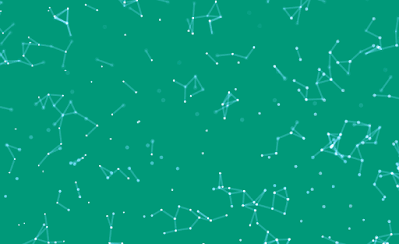It draws a floating starry sky with the node garden technique.
Starry sky with node garden technique.
It's a creative coding work made with the 'Processing'. It draws constellations with the node garden technique and moves these with the Perlin noise.
They often use PVector(random(width), random(height)) to make starfield, but it's not a good idea, I think. Result of random(width), random(height) often is unnatural. So I usually use PVector(++x, random(height)). It plots dots all over.
Example 'Processing' code.
This code do not display any images on screen but generates image files in frames directory. You can make an animation with these files.
Please feel free to use this example code under the terms of the GPL. To see other works based on my code is my pleasure. And my honor.
/**
* Aquarius.
* flowing constellations with Perlin noise.
*
* Processing 3.5.3
* @author @deconbatch
* @version 0.1
* created 0.1 2020.02.16
*/
void setup() {
size(720, 440);
colorMode(HSB, 360, 100, 100, 100);
blendMode(ADD);
noLoop();
}
void draw() {
int frmMax = 24 * 8; // 24fps x 8s animation with ease scene
int sceneMax = 2; // scene number
int starMax = 1000; // star number
float baseHue = random(360.0);
PVector stars[] = new PVector[starMax];
// make starfield
for (int lNum = 0; lNum < starMax; lNum++) {
if (lNum < starMax * 0.5) {
float sY = map(lNum, 0, starMax * 0.5, -height * 0.35, height * 1.35);
stars[lNum] = new PVector(random(-width * 0.35, width * 1.35), sY);
} else {
float sX = map(lNum, starMax * 0.5, starMax, -width * 0.35, width * 1.35);
stars[lNum] = new PVector(sX, random(-height * 0.35, height * 1.35));
}
}
for (int scene = 0; scene < sceneMax; scene++) {
for (int frmCnt = 0; frmCnt < frmMax; ++frmCnt) {
float frmRatio = map(frmCnt, 0, frmMax, 0.0, 1.0);
float easeRatio = easeInOutCubic(frmRatio);
float fading = constrain(sin(map(frmCnt + frmMax * scene, 0, frmMax * sceneMax, 0.0, PI)) * 30.0, 0.0, 1.0);
baseHue += easeRatio * 0.5;
background(baseHue % 360.0, 100.0, 60.0 * fading, 100.0);
noStroke();
for (int starCnt = 0; starCnt < starMax; starCnt++) {
float stRatio = map(starCnt, 0, starMax, 0.0, 1.0);
float stNoise = map(noise(stRatio), 0.0, 1.0, -1.0, 1.0);
float frNoise = noise(frmRatio);
float esNoise = noise(easeRatio);
float coNoise = map(noise(stars[starCnt].x / width, stars[starCnt].y / height), 0.0, 1.0, -1.0, 1.0);
float szRatio = sin(TWO_PI * (stNoise * 2.0 + frNoise * 3.0));
stars[starCnt].x += 0.5 * (cos(TWO_PI * stRatio) * 0.2 + coNoise + stNoise - frNoise + easeRatio * easeRatio * 2.0);
stars[starCnt].y += 0.5 * (sin(TWO_PI * stRatio) * 0.2 + coNoise + stNoise - frNoise + easeRatio * 1.2);
float sSiz = map(szRatio, -1.0, 1.0, 2.0, 8.0);
float sBri = map(szRatio, -1.0, 1.0, 100.0, 5.0);
fill((baseHue + 90.0 + stRatio * 60.0) % 360.0, 60.0, sBri * fading, 100.0);
ellipse(stars[starCnt].x, stars[starCnt].y, sSiz, sSiz);
}
strokeWeight(3.0);
stroke((baseHue + 120.0) % 360.0, 40.0, 15.0 * fading, 100.0);
noFill();
for (int i = 0; i < starMax - 1; i++) {
for (int j = i + 1; j < starMax; j++) {
float d = dist(stars[i].x, stars[i].y, stars[j].x, stars[j].y);
if (d > 20 && d < 30) {
line(stars[i].x, stars[i].y, stars[j].x, stars[j].y);
continue;
}
}
}
saveFrame("frames/" + String.format("%04d", scene) + String.format("%04d", frmCnt) + ".png");
}
}
exit();
}
/**
* easeInOutCubic easing function.
* @param t 0.0 - 1.0 : linear value.
* @return float 0.0 - 1.0 : eased value.
*/
private float easeInOutCubic(float t) {
t *= 2.0;
if (t < 1.0) {
return pow(t, 3) / 2.0;
}
t -= 2.0;
return (pow(t, 3) + 2.0) / 2.0;
}
/*
Copyright (C) 2020- deconbatch
This program is free software: you can redistribute it and/or modify
it under the terms of the GNU General Public License as published by
the Free Software Foundation; either version 3 of the License, or
(at your option) any later version.
This program is distributed in the hope that it will be useful,
but WITHOUT ANY WARRANTY; without even the implied warranty of
MERCHANTABILITY or FITNESS FOR A PARTICULAR PURPOSE. See the
GNU General Public License for more details.
You should have received a copy of the GNU General Public License
along with this program. If not, see <http://www.gnu.org/licenses/>
*/
Yet another example images.









